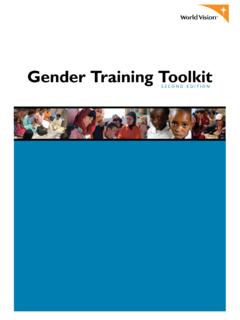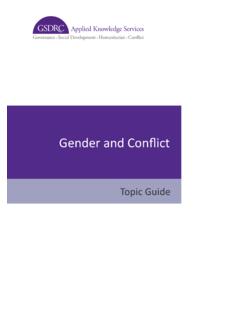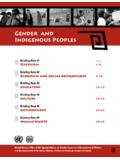Transcription of Native American Cultures: Family Life, Kinship, and Gender
1 Native American Cultures: Family life , kinship , and Gender Native American societies are based on the concept of interdependence. Interdependence means that all things in the universe are dependent on one another. The idea is that everything in the universe works together to achieve a balance in oneself, the community, and the universe. In Native American societies before their contact with European culture , relationships intertwined both animate beings and inanimate beings (for example, trees and water). The philosophical and sacred notion of interdependence produced a well-defined kinship system.
2 Precontact Native Americans lived in kinship societies, and extended Family groups formed their communities. The extended Family , made up of blood and nonblood relatives, had at its core the nuclear Family . The nuclear Family consisted of a woman, her husband, and their children. Many tribes practiced polygamy, in which a man had two or more wives, while other tribes were monogamous. Both men and women initiated divorce, which was common and not considered immoral. Some tribes, including the Navajo, Crow, Iroquois, and the Cherokee, were (and are) organized around the clan system. A clan may be defined as a group of relatives who share an identity, hold property in common, and trace their descent from a common ancestor.
3 The clan includes several extended families. Clan systems of social organization define boundaries or relationships, responsibilities, and obligations. All kinship networks have rules for appropriate behavior. For instance, it is inappropriate for clan relatives to marry each other even though they may not be blood relatives. Moreover, all kinship systems work to ensure the orderliness and survival of the tribe, which encompasses the nuclear families, the extended families, and the clans. Many tribes from the Northeast, Southeast, and Southwest were matrilineal or matrilocal. In these tribes, married couples lived near the wife's Family , the mother was the center of the Family , and her children received their identity from her Family .
4 Additionally, the wife was an equal to her husband and his Family , not a dependent. Other tribal groups, such as the tribes of the Great Plains, were patrilineal or patrilocal. In them, the father was the center of the Family , the newly married couple moved near the husband's Family , and descent was passed through the husband's Family . In addition to the kinship systems, tribes have informal and formal methods of organizing the community and ensuring conformity. For example, among the Crow Indians, there exists the idea of "teasing cousins." Teasing cousins could ridicule other teasing cousins into proper behavior.
5 The teasing, often conducted in public, resulted in the person being teased adopting appropriate behavior and humility. The Navajos, as well as other tribal groups, have a similar relationship system, which is used to control behavior. Another way to achieve order was through a division of labor based on Gender and aimed at ensuring that tasks essential to the well-being of the tribe were accomplished. Each tribe had its own system for assigning roles to women and men--a system that was based on the tribe's beliefs and the cultural values. While division of labor by Gender was well defined, the divisions could be crossed; that is, males might perform female tasks and vice versa without the individual's being labeled "deviant.
6 " Given the notion of interdependence, it is not surprising that many precontact Native American societies were egalitarian. Although groups maintained a division of labor by Gender , they had economic, political, and social freedom for both women and men. The sexes remained different, yet equal, and female and male roles complemented each other. Each role was seen as important and necessary for the survival and enrichment of the community. Women's and men's responsibilities were thought of and institutionalized as parallel rather than hierarchical. In the egalitarian Native societies, authority was dispersed and decisions were made by those who would be carrying them out.
7 People contributed according to their abilities and interests. Within the Family , Native American children learned cultural and societal values. While the tribal groups varied in their traditional child-rearing beliefs and practices, Native American children modeled and imitated the behaviors of important people in their lives. In the extended Family network, which was the foundation of tribal societies, many people other than biological relatives were included in child rearing. Although child rearing was predominantly a female task, men and women of all ages worked together to raise children.
8 In tribal societies, children were valued members; they represented the renewal of life . Traditional education of children involved the use of stories, humor, and theater; experience as a primary tool for learning was emphasized. Children were taught a deep appreciation for the meaning of community. Although seen as individuals, children were reared to be responsible to the community and to understand that the community was only as strong as its individual members. From the beginning of contact with Europeans, Native American societies began to change. By the 1800s, the federal government had in place two overlapping approaches regarding the treatment of Native Americans, and both were implemented through various policies.
9 One was to "civilize" Native Americans through a policy of assimilation; the other was to control them. By 1871, most Native American groups had signed treaties and were placed on reservations, where they lived in abject poverty. After being displaced from their original homelands, Native Americans found that the government had banned many spiritual ceremonies. The bans made it increasingly difficult for Native Americans to balance their world. A once sacred world had become unsacred, unholy. Moreover, many Native Americans (for example, the Salish and Kootenai tribes in Montana) were subjected to the pass system; in order to leave the reservation boundaries, they needed a form, or pass, signed by the Indian agent.
10 Assimilation and control tactics are key in understanding the transformation in Native American Family life . Economic changes, racial and cultural conflicts, and Gender relations interacted to produce altered Family systems. Indeed, forced colonization disrupted the traditional roles of Native Americans. The fur trade had an impact on the Family as well. Men were involved in trapping and trading, while women became more dependent on men for survival. Egalitarian arrangements gave way to patriarchal systems. Extended Family networks found in contemporary tribal societies differ from those in Native societies before contract with European cultures.







